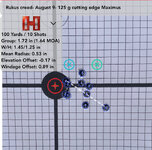DagOtto
Lil-Rokslider
- Joined
- Jun 19, 2024
- Messages
- 157
Hi,
I’m curious as to people’s input on using mean radius vs. max spread for bullet selection.
I have a new rifle in 6.5 CM, I’ve been shooting 10 shot groups of various factory loaded bullets to try to determine which bullet to go with. I don’t reload.
I’m 7 groups in so far. My 10 shot groups have varied from .48 -.70 inches and max spreads have varied from 1.72-2.16 Inches. I’m shooting off of sand bags on a bench at 100 yards. I count all shots. (No flyers) I’m using the group analysis tool on the Hornsay 4FOF app to document and measure.
I’ve heard lots of people indicate that for determining maximum ethical shooting distances one should use maximum spread which makes sense to me.
But, my question is in relationship to picking the most accurate bullet. Shouldn’t I use mean radius for that?
My reasoning is that my own shooting form (or lack there of,) is likely causing the two worst bullet placements in a group of 10. It seems unfair to blame the bullet for what is very likely my own shooting errors.
Because of this it seems more realistic that the most accurate bullet will be indicated by Mean Radius.
Thoughts ?
DO
I’m curious as to people’s input on using mean radius vs. max spread for bullet selection.
I have a new rifle in 6.5 CM, I’ve been shooting 10 shot groups of various factory loaded bullets to try to determine which bullet to go with. I don’t reload.
I’m 7 groups in so far. My 10 shot groups have varied from .48 -.70 inches and max spreads have varied from 1.72-2.16 Inches. I’m shooting off of sand bags on a bench at 100 yards. I count all shots. (No flyers) I’m using the group analysis tool on the Hornsay 4FOF app to document and measure.
I’ve heard lots of people indicate that for determining maximum ethical shooting distances one should use maximum spread which makes sense to me.
But, my question is in relationship to picking the most accurate bullet. Shouldn’t I use mean radius for that?
My reasoning is that my own shooting form (or lack there of,) is likely causing the two worst bullet placements in a group of 10. It seems unfair to blame the bullet for what is very likely my own shooting errors.
Because of this it seems more realistic that the most accurate bullet will be indicated by Mean Radius.
Thoughts ?
DO

